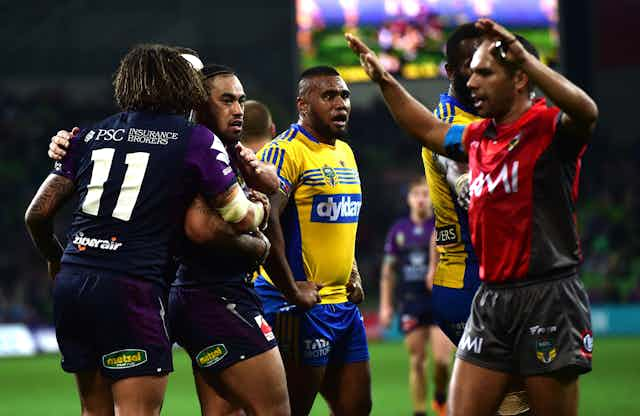A new centralised video bunker is set to be introduced to the National Rugby League (NRL) games next season as part of a A$2 million hi-tech overhaul.
The aim is to reduce dramas surrounding refereeing decisions in the code, with rugby league being the first sport in Australia to have such a command centre.
Up to now the video referees have been based at the venue during a game. The new Sydney-based centre will use Hawk-Eye Innovations video review technology and give the video referees access to multiple camera angles and playback control for all reviewable decisions.
Expectations are high that with this type of advanced technical assistance, referees will get more decisions correct and that significantly less time will be taken to reach those decisions.
What’s all the fuss?
But according to recent NRL data, referees are getting try-scoring decisions right at the highest rate since the directive to rule on tries before referring them upstairs to the video referee.
Referees had an 86% success rate over the opening eight rounds of the 2015 competition, compared with an 83% success rate for the entire 2014 season. Further data reveals that the overall accuracy of NRL referees decisions (80% accuracy) was only just behind the AFL (84%). It was ahead of both the football (70%) and rugby (50%) codes.
How then will the introduction of a central command system be the ultimate “game changer” that NRL head of football Todd Greenburg has predicted? The on-field referee evidence already appears to suggest that officials have the capacity to get decisions right the majority of the time.
How does the effectiveness of the proposed Central Command Centre, to be based at NEP Australia at Australian Technology Park in Eveleigh, compare with the immediacy (and integrity) of the real-time decisions being put forward by their on-field referee teams each week?
According to Greenberg, the aim of the new referral system is to increase the accuracy and consistency of decisions, and to reduce the amount of time taken to come to those decisions.
Call for ‘zero errors’
In trials conducted during the Round 12 Warriors v Knights game, the average time taken to make decisions reduced from 58.5 seconds down to just 20.3 seconds.
In testing conducted over 11 games during the 2015 season, it was reported that both accuracy and efficiency levels improved. There was also a more consistent approach to decision-making due to fewer people making the decisions. It also helped not having to rely on vision dictated to by the host broadcaster.
It appears that Greenberg’s bold prediction of video referees within the new bunker making zero errors next year may be a distinct possibility.
One un-named NRL coach, who’s also a fan of the video ref, is reported saying that players and coaches work too hard and train too hard for matches to be decided by 50-50 calls of getting decisions right.
The video ref is here to stay. It’s not going anywhere. It will be part of the new bunker.
A close call
Every try has now got millimetres in it, so we’ve got to make sure we’re using the right technology to keep up with how the athletes are performing.
Experienced commentators report that the frustration of fans dramatically increases when they see the referee rule a try, only to have it taken away from them after sitting through an extended replay process.
So how do you correct the immediate impact of a particular referee’s on-field decision when no referral is required, such as the one that enabled St George Illawarra five-eighth Gareth Widdop to send their elimination final this year against the Canterbury Bulldogs into extra time?
The abrupt answer is: we won’t. We will still have moments of controversy as there is no perfect system yet designed.
While the use of new technology is geared towards aiding the officials on site, reality suggests that different stadium configurations or breakdowns in communication between referees on-site could still change the outcome of games.
Just because certain systems have made judgements more accurate in one sport, doesn’t necessarily mean it will do the same for the NRL.
But the accumulating evidence from current United States professional sports suggests that one thing a central officiating location does bring is consistency to referred outcomes. The call you get one day is more likely going to be the same as the call the next day, and the next week because it should be the same people adjudicating it.
Seeing an incident as it is occurs in real-time from a wider range of broadcast angles, without distractions and with the same two people processing the information, should theoretically make for a more thorough and effective decision making process.
So regardless of opinion, the presence of the video referral system now appears to be an entrenched component in the game.
Referees will still be charged with the on-field responsibility for making most of the real-time decisions and deciding when to send these for review. The new off-site centralised video referees will be used to provide immediate support for on-field referee queries.
In that way, the transparency, speed and accuracy of decision-making may be improved next year, while at the same time potentially providing future frameworks of instruction that support even longer on-field and technological advancements for the sport of rugby league.

